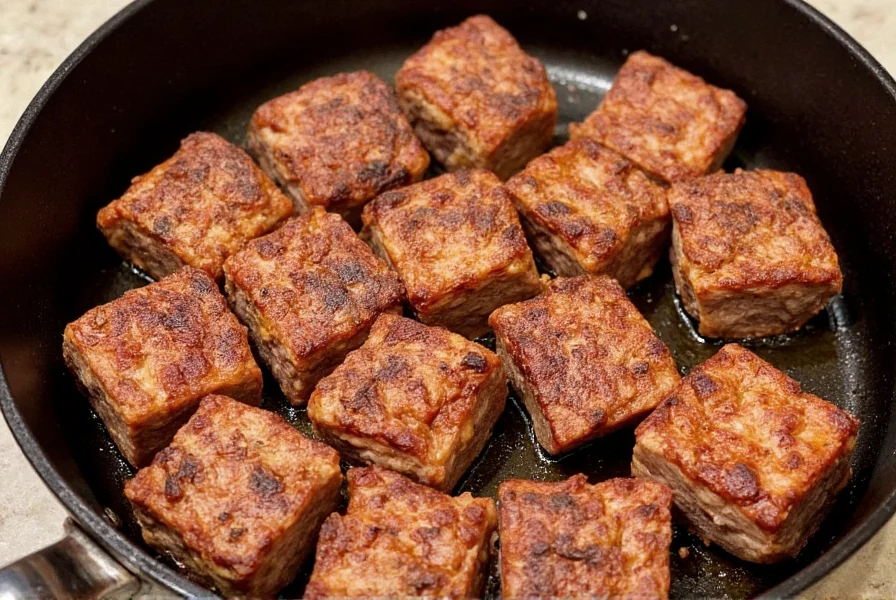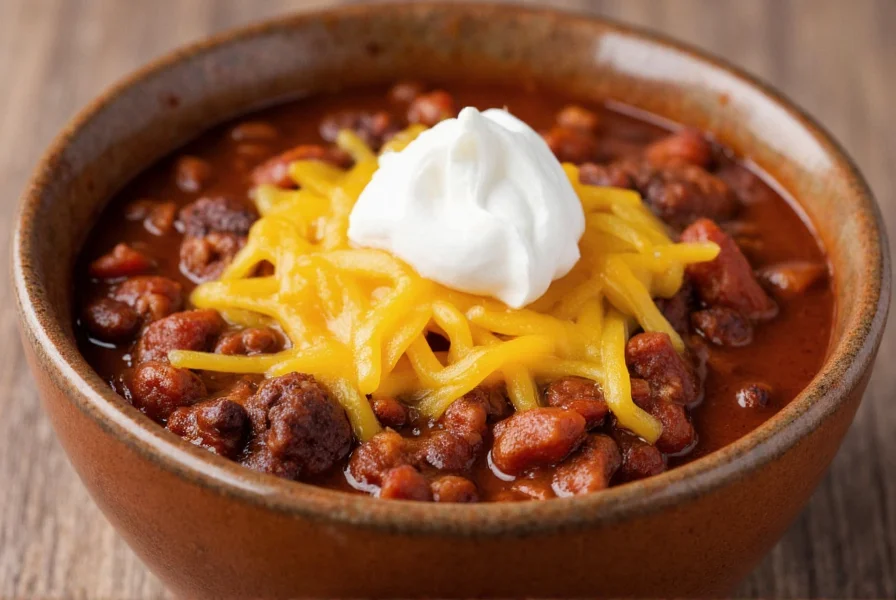When you choose chuck roast for chili, you're selecting a cut that transforms during the cooking process. The intramuscular fat and collagen in chuck roast melt at low temperatures, basting the meat from within and creating that signature melt-in-your-mouth texture that ground beef simply can't match. Unlike leaner cuts that dry out, chuck roast becomes more succulent the longer it simmers, making it perfect for slow cooker chuck roast chili recipes or stovetop preparations.
Why Chuck Roast Outperforms Other Cuts for Chili
Chuck roast comes from the shoulder area of the cow, which gets significant exercise. This results in more connective tissue than tenderloin or sirloin, but that's exactly what makes it ideal for chili. As the collagen breaks down during cooking, it transforms into gelatin, creating that luxurious mouthfeel professional chefs prize.
Compare this to ground beef, which often contains varying fat percentages and can become grainy when overcooked. Chuck roast vs ground beef for chili isn't even a contest when you want restaurant-quality results. The whole-muscle cut maintains its integrity while developing complex flavors through the Maillard reaction during proper searing.

Essential Ingredients for Flavorful Chuck Roast Chili
The magic happens when quality ingredients meet proper technique. For the best chuck roast chili recipe, you'll need:
- 3-4 pounds chuck roast, cut into 1½-inch cubes (fat partially trimmed)
- 2 tablespoons vegetable oil for searing
- 1 large yellow onion, diced
- 4 cloves garlic, minced
- 2-3 chipotle peppers in adobo sauce
- 2 tablespoons ancho chili powder
- 1 tablespoon cumin
- 2 (28-ounce) cans crushed tomatoes
- 1 (15-ounce) can kidney beans, drained
- 2 cups beef broth (low sodium)
Step-by-Step Cooking Method
Follow this professional technique for tender chuck roast chili every time:
- Prep the meat: Pat chuck roast cubes completely dry with paper towels. Moisture prevents proper searing.
- Sear properly: Heat oil in heavy Dutch oven until shimmering. Sear meat in batches without crowding, about 3-4 minutes per side until deeply browned. This develops complex flavor compounds through the Maillard reaction.
- Sauté aromatics: Cook onions until translucent, then add garlic and spices, stirring for 1 minute until fragrant.
- Combine ingredients: Return all meat to pot with tomatoes, chipotles, and broth. Liquid should just cover ingredients.
- Slow cook: Cover and cook at recommended temperatures (see table below).
| Cooking Method | Temperature | Cooking Time | Texture Result |
|---|---|---|---|
| Stovetop | Low simmer (180-200°F) | 2.5-3 hours | Fork-tender, shreds easily |
| Slow Cooker | Low setting | 7-8 hours | Melts in mouth, perfect for chuck roast chili recipe slow cooker |
| Oven | 300°F | 3 hours | Even cooking, minimal attention needed |
Critical Temperature Guidelines
Understanding what temperature to cook chuck roast chili is crucial. Never boil chili vigorously, as this makes meat tough. Maintain a gentle simmer where bubbles occasionally break the surface. The ideal temperature range is 180-200°F (82-93°C). At this temperature, collagen breaks down without causing muscle fibers to contract excessively.
Use an instant-read thermometer to verify your cooking temperature. If using a slow cooker, ensure it maintains at least 180°F to stay out of the food danger zone while still cooking gently.

Pro Tips for Exceptional Flavor
Elevate your chuck roast chili cooking time results with these chef-recommended techniques:
- Acid balance: Add 1 tablespoon of apple cider vinegar during the last 30 minutes to brighten flavors
- Layer spices: Bloom dried spices in oil before adding liquids to maximize flavor extraction
- Rest overnight: Chili always tastes better the next day as flavors meld
- Skim fat: After refrigeration, solidified fat easily removes from surface for cleaner flavor
- Texture control: For thicker chili, remove 1-2 cups of meat and broth, shred meat, and return to pot
Avoiding Common Mistakes
Even experienced cooks make these errors with how to make chili with chuck roast:
- Skipping the sear: Proper browning creates hundreds of flavor compounds
- Overcrowding the pan: Causes steaming instead of searing - work in batches
- Boiling instead of simmering: Makes meat tough rather than tender
- Underseasoning: Chili needs more salt than you might expect - season in layers
- Rushing the process: How long to cook chuck roast for chili properly requires patience - don't shorten cooking time
Serving and Storage Recommendations
Serve your chuck roast chili with traditional toppings like shredded cheddar, sour cream, and fresh cilantro. For special occasions, try fried onions, avocado slices, or a dollop of lime crema.
Store leftovers in airtight containers for up to 4 days in the refrigerator or freeze for up to 3 months. Reheat gently on the stovetop with a splash of broth to restore moisture. Remember that chuck roast chili reheats beautifully, often improving in flavor after the first day.
Final Thoughts
Mastering chuck roast chili requires understanding the science behind the cut and cooking process. By following these precise techniques for searing, temperature control, and seasoning, you'll create chili with depth of flavor and texture that ground beef versions simply cannot match. The investment of time pays off with a dish that satisfies both casual weeknight dinners and special occasions.
Frequently Asked Questions
Can I use a different cut of beef for chili if I can't find chuck roast?
While chuck roast is ideal, you can substitute with brisket or short ribs for similar results. These cuts also contain abundant connective tissue that breaks down during slow cooking. Avoid lean cuts like sirloin or round, which will become dry and tough. For best results with alternative cuts, maintain the same low-and-slow cooking method at 180-200°F for 2.5-3 hours.
How do I know when my chuck roast chili is done cooking?
Your chuck roast chili is perfectly cooked when the meat shreds easily with a fork but hasn't completely disintegrated. The internal temperature of the meat should reach 195-205°F, where collagen has fully converted to gelatin. If pieces still feel resistant when pierced with a fork, continue cooking. Properly cooked chuck roast should separate along natural muscle lines with minimal pressure.
Should I trim all the fat from chuck roast before making chili?
Leave about 20-30% of the fat on chuck roast for chili. This intramuscular fat bastes the meat during cooking, creating rich flavor and preventing dryness. Excessive external fat can be trimmed, but don't remove all marbling. During cooking, excess fat will rise to the surface and can be easily skimmed off after refrigeration, allowing you to control richness in the final dish.
Can I make chuck roast chili in an Instant Pot?
Yes, you can make excellent chuck roast chili in an Instant Pot. Sear the meat using the sauté function, then pressure cook on high for 45 minutes followed by a natural 15-minute release. While faster than traditional methods, the Instant Pot won't develop the same depth of flavor as slow simmering, so consider finishing with 20-30 minutes of simmering on sauté mode to concentrate flavors and improve texture.










 浙公网安备
33010002000092号
浙公网安备
33010002000092号 浙B2-20120091-4
浙B2-20120091-4